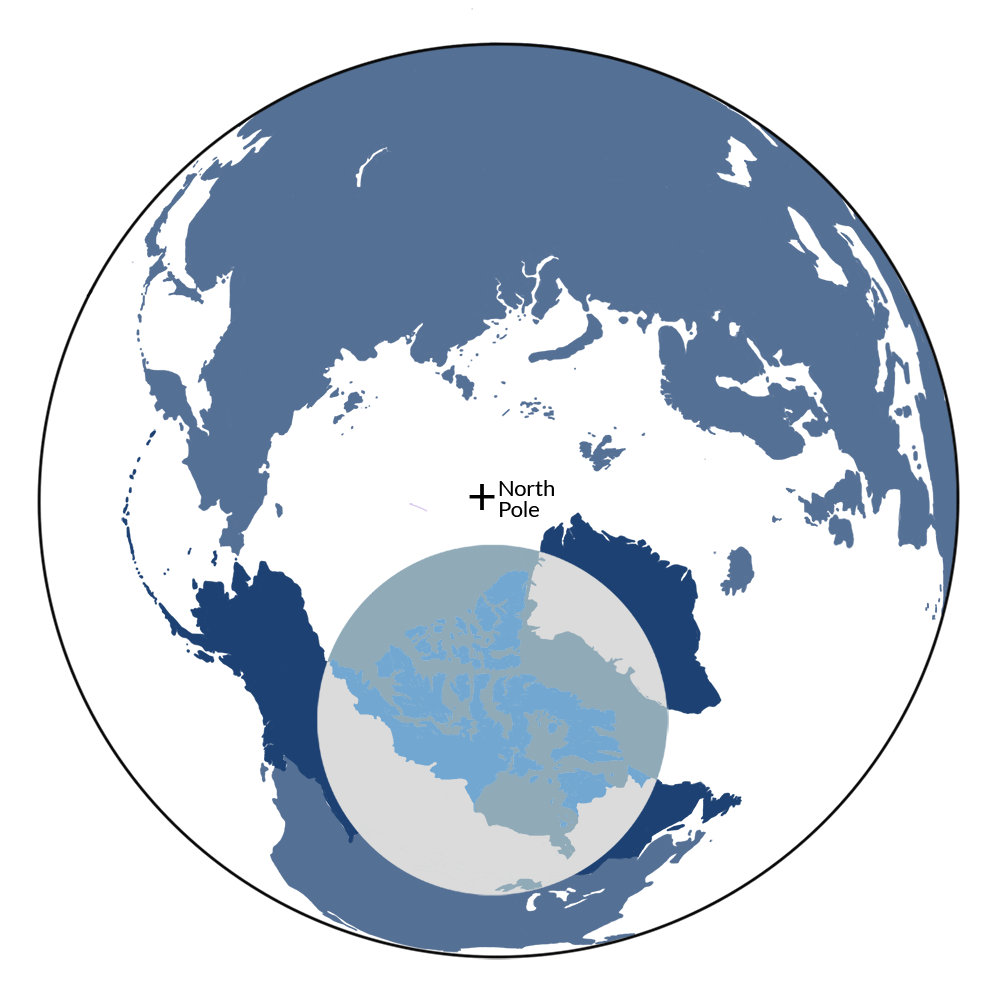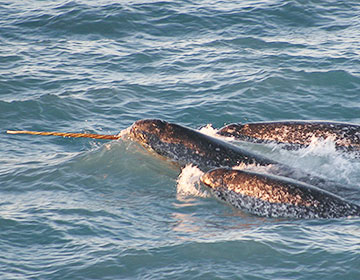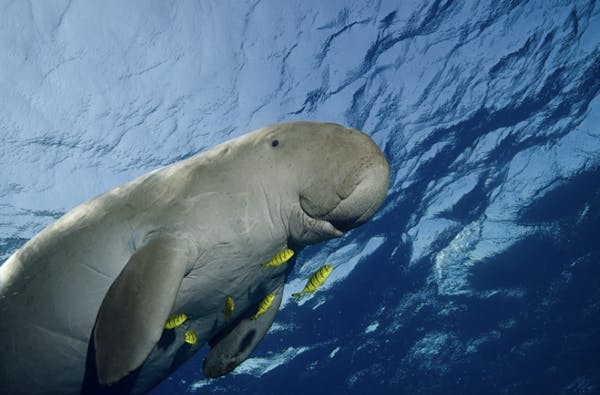Meet the narwhal, the long-toothed whale that inspired worldwide legends
- Nature Conservation
- Ocean Conservation
- Iconic Species
- Wildlife
- Canadian Tundra
- Subarctic America Realm
One Earth’s “Species of the Week” series highlights an iconic species that represents the unique biogeography of each of the 185 bioregions of the Earth.
Narwhals (Monodon monoceros) stand out for their beautiful tusks. In medieval times, greedy kings and queens would seek out and buy narwhal tusks, considering them to be magical unicorn horns, sparking the legend.
For the Inuktitut nation, they are revered and considered “the ones that point to the sky,” Qilalugaq gernertaq.

The narwhal (Monodon monoceros) is the iconic species of the Canadian Tundra bioregion (NA2) located in Subarctic America.
Life in the cold waters of the Arctic
With an estimated population of around 100,000, narwhals are mostly found around the fjords, or narrow glacier inlets, of Northeastern Canada, Greenland, and the Arctic Ocean's Atlantic sector.
Female narwhals are slightly smaller than males, weighing up to 1,550 kilograms (3,417 lb), while males can reach weights of up to 1,900 kilograms (4,188 lb). Over 40% of their body weight comprises fat or blabber under the skin.
Their body length is about five meters (16 ft) for females and five and a half meters (18 ft) for males. Tusks measure between 1.5 and 2.5 meters long (5-8 ft).
Unicorns of the sea
The tusk is actually a single tooth. Vestigial teeth exist in the early stages of maturity but never erupt and disappear before adulthood. On rare occasions, both the left and right front teeth develop into tusks.
Every male has a tusk, and about 15% of females do too. The tusk unfolds in a tight, leftward spiral that takes about five years to complete from the age of about two or three. The slowly spiraling tooth grows through the lip and not beneath it – as tusks in other mammals, such as elephants.
Tusks are used to sense water
Recent biological research shows that tusks are susceptible organs that provide relevant information about their surroundings. Narwhals can map out their favorite feeding, breeding, and wintering grounds based on the waters' depth, temperature, and salinity.
What makes Narwhal tusks so sensitive are the thousands of little pores on the surface. These channel water inwards towards the hard enamel that protects the core, where blood vessels and nerves run from the tip to the brain.
Adapted for deep-sea diving
Narwhals have many body adaptations to the cold Arctic waters. Some are anatomical. Their size and shape retain heat generated by cellular metabolism, and the thick blubber layer under the skin helps with insulation.
Other body adaptations are physiological. Arteries and veins in flippers run next to each other, so the arteries irrigating outwards warm up blood coming back into the body.
Aside from swimming in freezing waters, narwhals can remain deep below for almost half an hour. Nearly two decades ago, Kristin Laidre, a marine ecologist, attached sensors to the blubber and cartilage on the back of fourteen narwhals in Baffin Bay, Greenland. She determined they could dive as deep as 1,800 meters, practically reaching the sea floor.
Such depths are achieved through body chemistry
Such deep diving skills are thanks to their blood's hemoglobin and the muscle tissue's myoglobin, which is actively loaded with oxygen. Narwhals take long deep breaths during the resting time between dives, which replaces carbon dioxide with oxygen.
When they are ready to dive, their lungs expel all the air to avoid any nitrogen gas molecules from being forced into the blood system, which could be very harmful. While they are deep down, most organs in the body are bypassed in terms of blood irrigation. Only the vital organs, such as the brain and the heart, the tail, flippers, and the swallowing muscles, are irrigated.
After the first fifteen minutes, once the hemoglobin in the blood has been used by metabolic cells, the myoglobin begins to release its oxygen to the muscle tissues in need. This enables them to have a more efficient dive that lasts twenty-five minutes!

Ancestry and bonding with belugas
Narwhals have been around for some five million years, and they share a common, fully-toothed ancestor with beaked whales, sperm whales, and a few dolphin species. Their closest relative is the beluga, as they are the only two living members of the Monodontidae family that lack a dorsal fin, which may be an adaptation for swimming under sea ice.
The narwhal and the beluga are also the only cetaceans that dwell within the Arctic pack ice year-round. While other whales make long journeys to breed and give birth in warmer waters, narwhal and beluga pods make only relatively brief migratory trips to their wintering grounds between Canada and Greenland.
Recent studies have confirmed what the Inuktitut have known for a long time: that the beluga and narwhals can interbreed. Female belugas can give birth to narluga calves. This interbreeding may become more common as their mating and feeding grounds overlap.
Reproduction, aging, and life in pods
Narwhals’ gestation is 14 to 16 months long. They breed at the end of winter, around March, and give birth at the beginning of the following summer in shallow waters along the coast of Peel Sound and Northern Hudson Bay, all the way to Ellesmere Island. Calves get breastfed by their mothers for about a year.
Narwhals live to at least twenty-five years and can continue living until they are about fifty years old. Their skin color gradually changes from brownish-gray to dark black spots. Later, they lighten until they become white with black mottles on the head, flippers, dorsal ridge, and flukes.
Pods can hold anywhere between two and a dozen individuals during winter. When the waterways open up in summer due to the ice melting, they can concentrate large, dispersed groups of hundreds to thousands.
Indigenous-led conservation efforts
Biological and ecological information about narwhals has been collected over the decades, primarily thanks to the Inuktitut who live in the Arctic circle. They have traditionally needed to hunt narwhals, among other animals, to provide their family with food through the winter. Their hunting skills are always helpful to marine biologists, some of whom come from the Inuktitut nation.
Currently, the narwhal’s conservation status is Special Concern. The Marine Protection Act safeguards them, but they are threatened by climate change and melting ice.
Efforts to create safe grounds have been ongoing for over two decades thanks to the initiative of Native Nations in the Nunavut Territory in Canada. In 2017. the Qikiqtani Inuit Association, the Government of Canada, and Nunavut celebrated an agreement on a boundary for the Tallurutiup Imanga / Lancaster Sound National Marine Conservation Area.
Such conservation programs continue to this day to protect narwhals, so these majestic unicorns of the sea remain ruling the icy waters of the Arctic.
Explore the Bioregions.jpg?auto=compress%2Cformat&w=1440)


.jpg?auto=compress%2Cformat&h=600&w=600)

